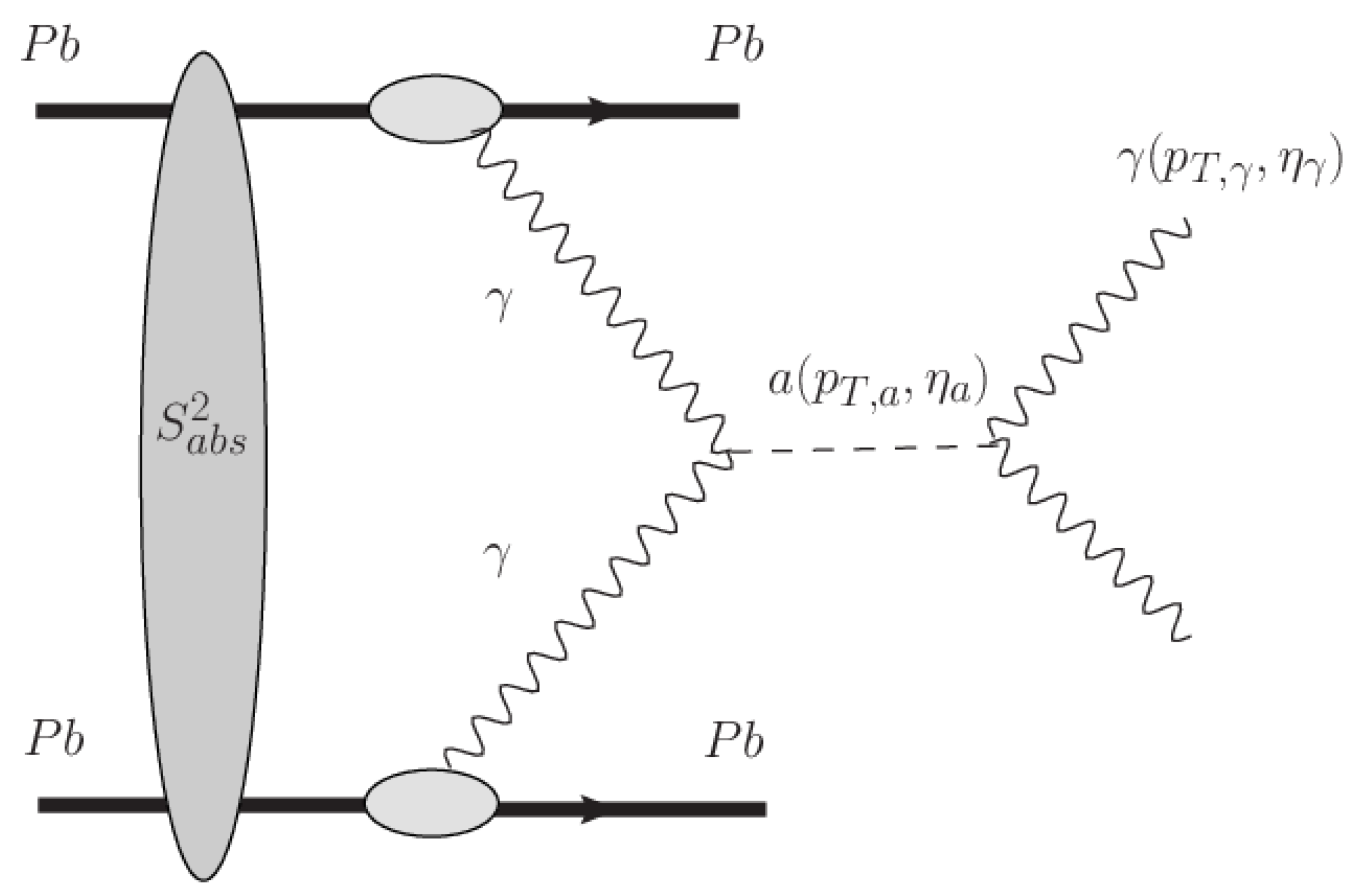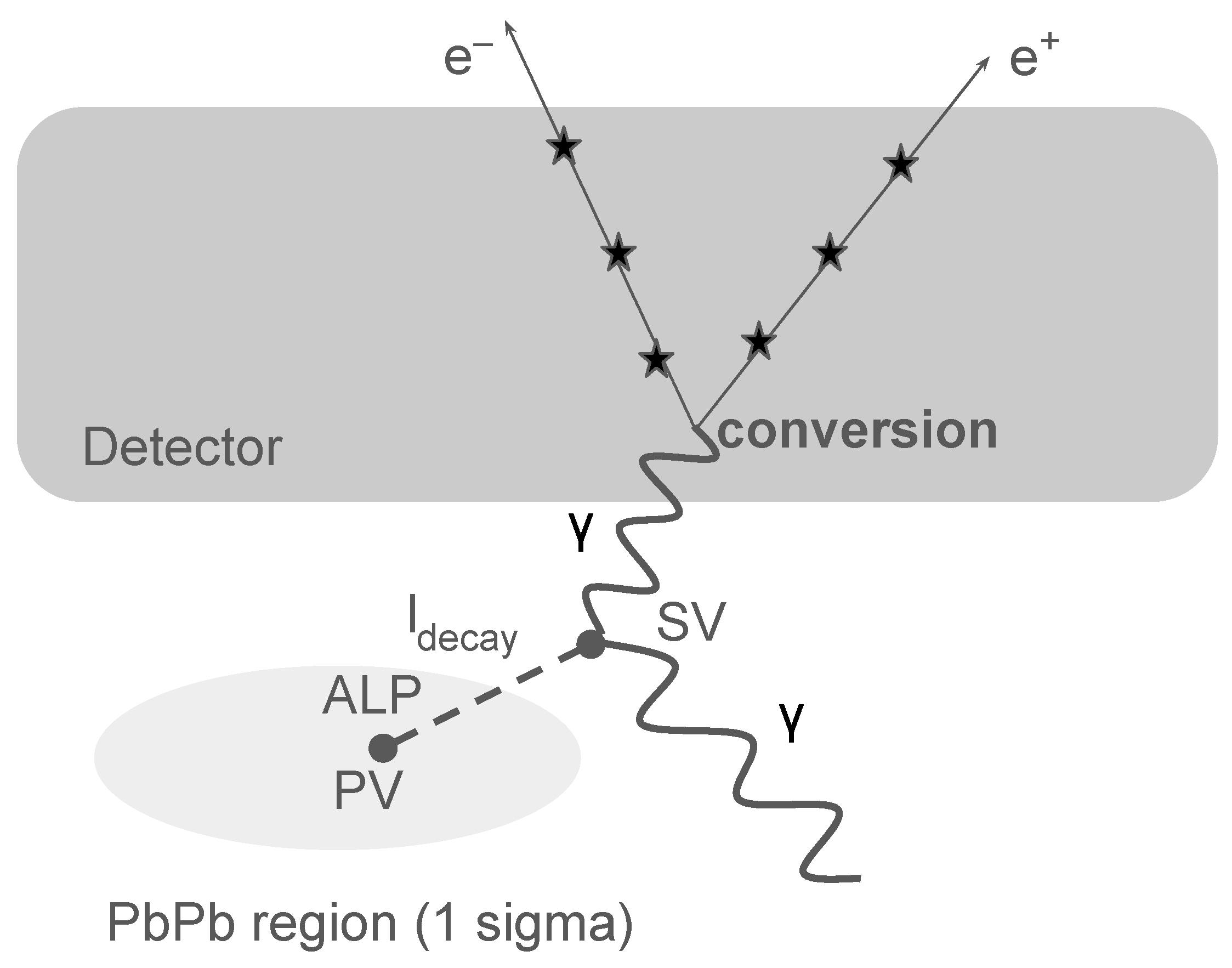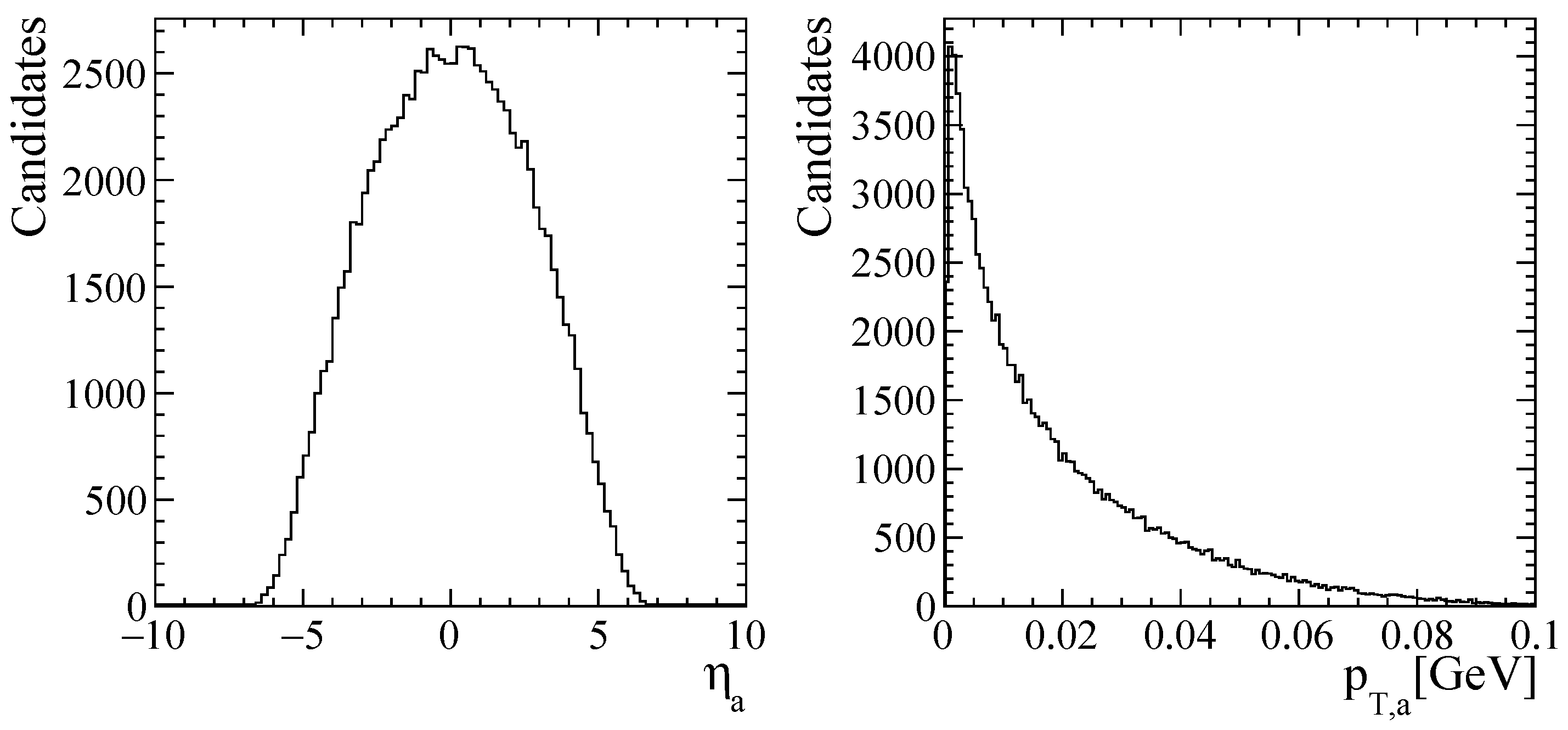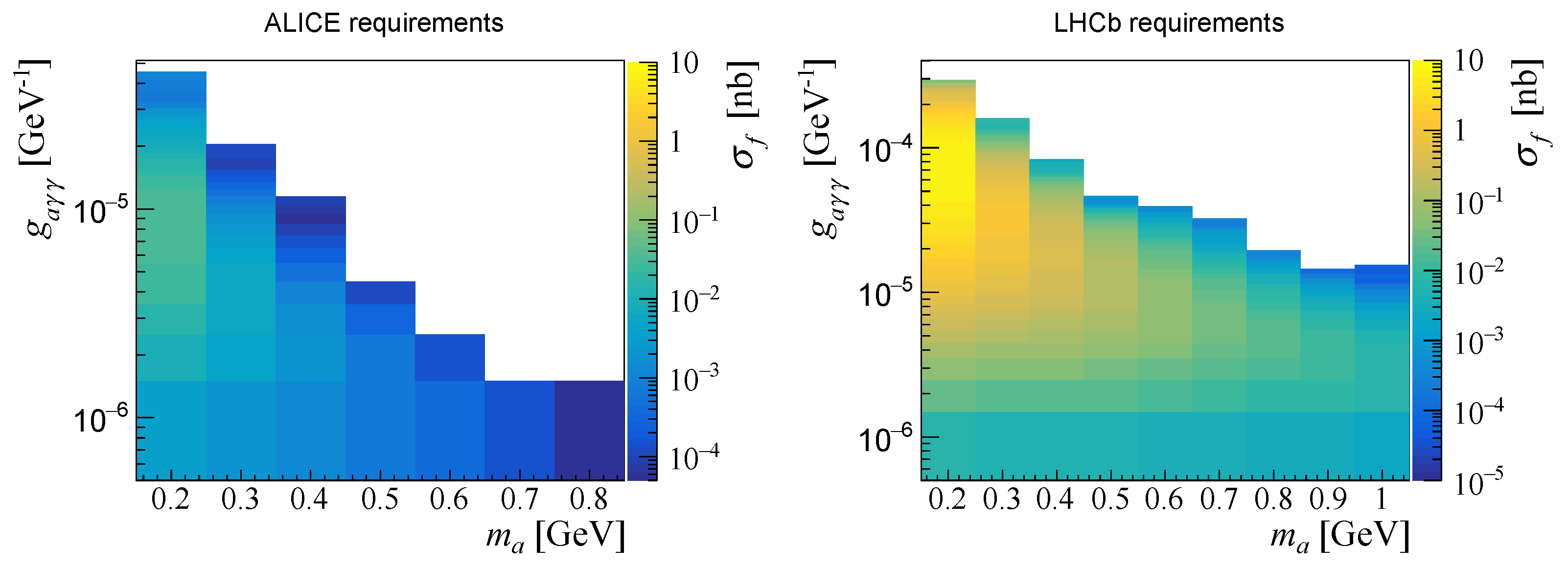Looking for New Strategies to Probe Low-Mass Axion-like Particles in Ultraperipheral Heavy-Ion Collisions at the LHC
Abstract
:1. Introduction
2. Search Strategy
3. Results
4. Summary
Author Contributions
Funding
Data Availability Statement
Acknowledgments
Conflicts of Interest
References
- Graham, P.W.; Irastorza, I.G.; Lamoreaux, S.K.; Lindner, A.; van Bibber, K.A. Experimental Searches for the Axion and Axion-Like Particles. Annual Review of Nuclear and Particle Science. Ann. Rev. Nucl. Part. Sci. 2015, 65, 485–514. [Google Scholar] [CrossRef]
- Schoeffel, L.; Baldenegro, C.; Hamdaoui, H.; Hassani, S.; Royon, C.; Saimpert, M. Photon–photon physics at the LHC and laser beam experiments, present and future. Prog. Part. Nucl. Phys. 2021, 120, 103889. [Google Scholar] [CrossRef]
- d’Enterria, D. Collider Constraints on Axion-Like Particles. Collider constraints on axion-like particles. arXiv 2021, arXiv:2102.08971. [Google Scholar]
- Jaeckel, J.; Spannowsky, M. Probing MeV to 90 GeV axion-like particles with LEP and LHC. Phys. Lett. B 2016, 753, 482. [Google Scholar] [CrossRef]
- Bauer, M.; Neubert, M.; Thamm, A. Collider Probes of Axion-Like Particles. J. High Energy Phys. 2017, 1712, 044. [Google Scholar] [CrossRef]
- Knapen, S.; Lin, T.; Lou, H.K.; Melia, T. Searching for Axionlike Particles with Ultraperipheral Heavy-Ion Collisions. Phys. Rev. Lett. 2017, 118, 171801. [Google Scholar] [CrossRef]
- Aloni, D.; Soreq, Y.; Williams, M. Coupling QCD-Scale Axionlike Particles to Gluons. Phys. Rev. Lett. 2019, 123, 031803. [Google Scholar] [CrossRef]
- Baldenegro, C.; Hassani, S.; Royon, C.; Schoeffel, L. Extending the constraint for axion-like particles as resonances at the LHC and laser beam experiments. Phys. Lett. B 2019, 795, 339. [Google Scholar] [CrossRef]
- Aloni, D.; Fanelli, C.; Soreq, Y.; Williams, M. Photoproduction of Axionlike Particles. Phys. Rev. Lett. 2019, 123, 071801. [Google Scholar] [CrossRef]
- Bauer, M.; Heiles, M.; Neubert, M.; Thamm, A. Axion-Like Particles at Future Colliders. Eur. Phys. J. C 2019, 79, 74. [Google Scholar] [CrossRef]
- Yue, C.X.; Liu, M.Z.; Guo, Y.C. Searching for axionlike particles at future ep colliders. Phys. Rev. D 2019, 100, 015020. [Google Scholar] [CrossRef]
- Ebadi, J.; Khatibi, S.; Mohammadi Najafabadi, M. New probes for axionlike particles at hadron colliders. Phys. Rev. D 2019, 100, 015016. [Google Scholar] [CrossRef]
- Coelho, R.O.; Gonçalves, V.P.; Martins, D.E.; Rangel, M.S. Production of axionlike particles in PbPb collisions at the LHC, HE–LHC and FCC: A phenomenological analysis. Phys. Lett. B 2020, 806, 135512. [Google Scholar] [CrossRef]
- İnan, S.C.; Kisselev, A.V. A search for axion-like particles in light-by-light scattering at the CLIC. J. High Energy Phys. 2020, 06, 183. [Google Scholar] [CrossRef]
- Kłusek-Gawenda, M.; McNulty, R.; Schicker, R.; Szczurek, A. Light-by-light scattering in ultraperipheral heavy-ion collisions at low diphoton masses. Phys. Rev. D 2019, 99, 093013. [Google Scholar] [CrossRef]
- Gonçalves, V.P.; Martins, D.E.; Rangel, M.S. Searching for axionlike particles with low masses in pPb and PbPb collisions. Eur. Phys. J. C 2021, 81, 522. [Google Scholar] [CrossRef]
- Zhang, H.Y.; Yue, C.X.; Guo, Y.C.; Yang, S. Searching for axionlike particles at future electron-positron colliders. Phys. Rev. D 2021, 104, 096008. [Google Scholar] [CrossRef]
- Yue, C.X.; Zhang, H.Y.; Wang, H. Production of axion-like particles via vector boson fusion at future electron-positron colliders. Eur. Phys. J. C 2022, 82, 88. [Google Scholar] [CrossRef]
- Rebello Teles, P.; d’Enterria, D.; Gonçalves, V.P.; Martins, D.E. Searches for axionlike particles via γγ fusion at future e+e- colliders. Phys. Rev. D 2024, 109, 5. [Google Scholar]
- Balkin, R.; Hen, O.; Li, W.; Liu, H.; Ma, T.; Soreq, Y.; Williams, M. Probing axion-like particles at the Electron-Ion Collider. J. High Energy Phys. 2024, 02, 123. [Google Scholar] [CrossRef]
- Sirunyan, A.M.; et al. [CMS Collaboration] Evidence for light-by-light scattering and searches for axion-like particles in ultraperipheral PbPb collisions at sNN= 5.02 TeV. Phys. Lett. B 2019, 797, 134826. [Google Scholar] [CrossRef]
- Aad, G.L.; et al. [ATLAS] Measurement of light-by-light scattering and search for axion-like particles with 2.2 nb−1 of Pb+Pb data with the ATLAS detector. J. High Energy Phys. 2021, 03, 243, Erratum in J. High Energy Phys. 2021, 11, 050. [Google Scholar]
- Alonso-Álvarez, G.; Jaeckel, J.; Lopes, D.D. Tracking axion-like particles at the LHC. arXiv 2023, arXiv:2302.12262. [Google Scholar]
- Baltz, A.J.; Baur, G.; d’Enterria, D.; Frankfurt, L.; Gelis, F.; Guzey, V.; Hencken, K.; Kharlov, Y.; Klasen, M.; Klein, S.R.; et al. The Physics of Ultraperipheral Collisions at the LHC. Phys. Rept. 2008, 458, 1–171. [Google Scholar] [CrossRef]
- Aad, G.; et al. [ATLAS Collaboration] Search for an axion-like particle with forward proton scattering in association with photon pairs at ATLAS. J. High Energy Phys. 2023, 07, 234. [Google Scholar]
- Tumasyan, A.; et al. [TOTEM and CMS Collaborations] Search for high-mass exclusive diphoton production with tagged protons in proton-proton collisions at s = 13 TeV. Phys. Rev. D 2024, 110, 012010. [Google Scholar]
- Budnev, V.M.; Ginzburg, I.F.; Meledin, G.V.; Serbo, V.G. The Two photon particle production mechanism. Physical problems. Applications. Equivalent photon approximation. Phys. Rept. 1975, 15, 181–281. [Google Scholar] [CrossRef]
- Azevedo, C.; Gonçalves, V.P.; Moreira, B.D. Exclusive dilepton production in ultraperipheral PbPb collisions at the LHC. Eur. Phys. J. C 2019, 79, 432. [Google Scholar] [CrossRef]
- Aaij, R.; Affolder, A.; Akiba, K.; Alexander, M.; Ali, S.; Appleby, R.B.; Artuso, M.; Bates, A.; Bay, A.; Behrendt, O.; et al. Performance of the LHCb Vertex Locator. J. Instrum. 2014, 9, P09007. [Google Scholar] [CrossRef]
- Benson, S.; Casais Vidal, A.; Cid Vidal, X.; Puig Navarro, A. Real-time discrimination of photon pairs using machine learning at the LHC. SciPost Phys. 2019, 7, 062. [Google Scholar] [CrossRef]
- Abelev, B.B.; et al. [ALICE Collaboration] Performance of the ALICE Experiment at the CERN LHC. Int. J. Mod. Phys. A 2014, 29, 1430044. [Google Scholar] [CrossRef]
- Harland-Lang, L.A.; Tasevsky, M.; Khoze, V.A.; Ryskin, M.G. A new approach to modelling elastic and inelastic photon-initiated production at the LHC: SuperChic 4. Eur. Phys. J. C 2020, 80, 925. [Google Scholar] [CrossRef]
- Acharya, S.; et al. [ALICE Collaboration] ALICE luminosity determination for Pb-Pb collisions at sNN=5.02 TeV. J. Instrum. 2024, 19, P02039. [Google Scholar] [CrossRef]
- Aaij, R.; et al. [LHCb Collaboration] Study of exclusive photoproduction of charmonium in ultra-peripheral lead-lead collisions. J. High Energy Phys. 2023, 06, 146. [Google Scholar]
- Bruce, R.; Jebramcik, M.A.; Jowett, J.M.; Mertens, T.; Schaumann, M. Performance and luminosity models for heavy-ion operation at the CERN Large Hadron Collider. Eur. Phys. J. Plus 2021, 136, 745. [Google Scholar] [CrossRef]
- d’Enterria, D.; Drewes, M.; Giammanco, A.; Hajer, J.; Bratkovskaya, E.; Bruce, R.; Burmasov, N.; Dyndal, M.; Gould, O.; Grabowska-Bold, I.; et al. Opportunities for new physics searches with heavy ions at colliders. J. Phys. G 2023, 50, 050501. [Google Scholar] [CrossRef]





Disclaimer/Publisher’s Note: The statements, opinions and data contained in all publications are solely those of the individual author(s) and contributor(s) and not of MDPI and/or the editor(s). MDPI and/or the editor(s) disclaim responsibility for any injury to people or property resulting from any ideas, methods, instructions or products referred to in the content. |
© 2025 by the authors. Licensee MDPI, Basel, Switzerland. This article is an open access article distributed under the terms and conditions of the Creative Commons Attribution (CC BY) license (https://creativecommons.org/licenses/by/4.0/).
Share and Cite
Nogarolli, P.; Gonçalves, V.P.; Rangel, M.S. Looking for New Strategies to Probe Low-Mass Axion-like Particles in Ultraperipheral Heavy-Ion Collisions at the LHC. Universe 2025, 11, 80. https://doi.org/10.3390/universe11030080
Nogarolli P, Gonçalves VP, Rangel MS. Looking for New Strategies to Probe Low-Mass Axion-like Particles in Ultraperipheral Heavy-Ion Collisions at the LHC. Universe. 2025; 11(3):80. https://doi.org/10.3390/universe11030080
Chicago/Turabian StyleNogarolli, Pedro, Victor P. Gonçalves, and Murilo S. Rangel. 2025. "Looking for New Strategies to Probe Low-Mass Axion-like Particles in Ultraperipheral Heavy-Ion Collisions at the LHC" Universe 11, no. 3: 80. https://doi.org/10.3390/universe11030080
APA StyleNogarolli, P., Gonçalves, V. P., & Rangel, M. S. (2025). Looking for New Strategies to Probe Low-Mass Axion-like Particles in Ultraperipheral Heavy-Ion Collisions at the LHC. Universe, 11(3), 80. https://doi.org/10.3390/universe11030080





